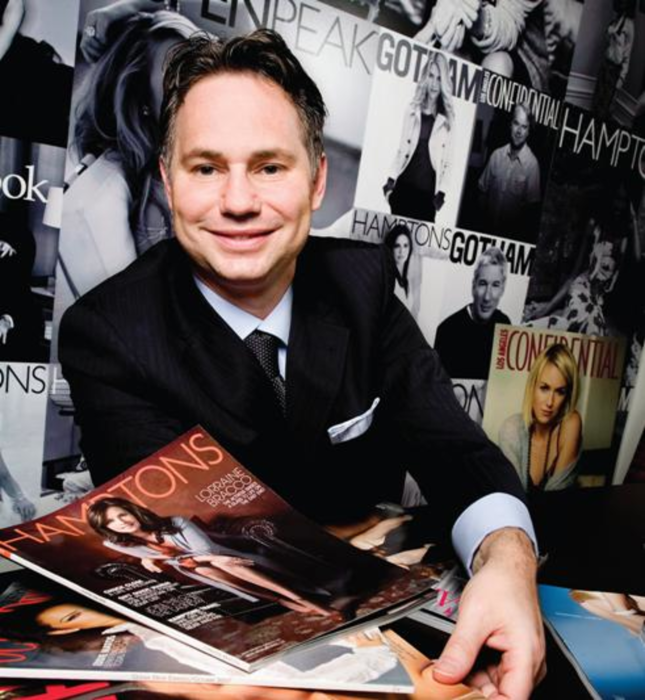Pricey casinos, Manhattan penthouses, dazzling diamonds — all are hallmarks of luxury, and all are featured in magazines such as those owned by Niche Media LLC. The company, presided over by Jason Binn, recently set a massive wave of growth in motion, kicking off this month with the launch of Trump. Another title, Gotham, which caters to New York’s elite, is increasing circulation by 15% in February, and Michigan Avenue, serving the cream of Chicago’s crop, debuts on October 2008.
“It’s been a constantly evolving, growing business, whether in staffing, advertising revenues or even in our office spaces,” says Jason Binn, CEO and founder of Niche Media. “The magazines have consistently grown by roughly 20% each year.”
More millionaires, more magazines
Luxury magazines are enjoying their time in the sun: Niche Media’s growth is complemented by the successful launch of super-glossy Monocle and the debut of Doubledown Media’s The Players Club, aimed at pro athletes — not to mention long-standing titles such as CurtCo’s The Robb Report.
This boom, however, means that many publications are jostling for a readership that is, by definition, elite. While the millionaire population has risen sharply in recent years — according to the Spectrem Group, the number of US households with a net worth of $1 million or more rose to a record 9 million in 2006 — there is still tight competition for the “right” readers. Likewise, high-end advertisers are being wooed for ad dollars from all sides. To compete, many luxury magazines focus on highly targeted, small circulation profiles and pristine design to make their titles advertiser-friendly.
As its name suggests, Niche Media’s magazines, such as Gotham and Vegas, focus tightly on the glittering social worlds of high-income areas and fill a community niche.
“When we started back in the early ’90s, it was a unique business model to feature localized city content and involve the most influential people in each city,” Binn says. “We mail or distribute the magazines in the most desirable places and to the most desirable readers, so there’s a complete vertical integration.”
Events bring readers to advertisers
Niche Media also puts on events as a way to build rapport with readers and introduce them to major advertisers, playing to the socialite lifestyle that advertisers also want to encourage.
“We do 500 A-list events across the country as a platform to let readers see the influencers and taste that marketplace,” says Binn. “It gives us instant credibility.”
Doubledown Media employs a similar strategy. A recent Mercedes-sponsored event invited readers to a charity boxing match, where Wall Street professionals duked it out in front of a black tie crowd.
“Magazines are great for branding, but events let you touch the customer,” affirms Randall Lane, president of Doubledown Media. “You meet some of the wealthiest people in America, all in one room.”
A cult of social celebrity helps drive the success of these magazines, says Dr. Samir Husni, creator of the blog Mr. Magazine and chair of the journalism department at the University of Mississippi.
“Those luxury magazines often depend on social celebrities,” Husni says. “It makes the advertisers feel they need to be in that magazine because if they’re not, they’re not part of this elite club. They have become the replacement of good-old-days country club gossip.”
The country club metaphor also fits because of the exclusivity of many of these titles. Niche Media works with list companies like Experian to quantify and qualify readers. The company then targets only potential readers earning more than $250,000 a year, with $1 million-plus homes and another $1 million-plus in liquid assets. About half of the magazines are then mailed to worthy readers. Another 15%-20% of the copies are placed in high-end hotels, while others are sent out to luxury car services and airlines.
Doubledown, on the other hand, targets people based solely on profession. “The only way you can know if people are truly rich is what they do for a living,” says Lane. “If you work at a hedge fund or you’re a pro athlete you’re doing really well right now, so we know we’re reaching a pure luxury audience.”
Chris Ramey, chairman of the Florida Luxury Marketing Council, says Florida Designers Review is another title with heavily guarded circulation. It cannot be purchased anywhere — recipients must be involved in the arts and the community and have a certain net worth.
“The value for the advertisers is not about high circulation numbers,” Ramey explains. “It’s that readers are perfectly qualified. Their model is completely different from a mass publication, which is looking to have outrageous circulation and is looking to create whatever is necessary on the front cover to sell the magazine.”
Though Niche Media is increasing Gotham‘s circulation from 60,000 to 70,000 copies per issue, the company is sticking to the quality over quantity rule. The small bump is more a response to the growth of the luxury market than an attempt to lure a broader generalized base.
“The luxury sector has grown over the past 15 years, so I feel [marketers’] desire to market and brand their businesses,” explains Binn. “Billboards, TV and Web are great, but they are connected to other brands that these brands may not want to be affiliated with. A magazine is a much more controlled way of getting your message out there.”
As far as luxury’s potential for longevity, Binn remains optimistic: “We’re all betting on the luxury market to keep going,” he says. “It’s something that I feel people arealways going to embrace.”








